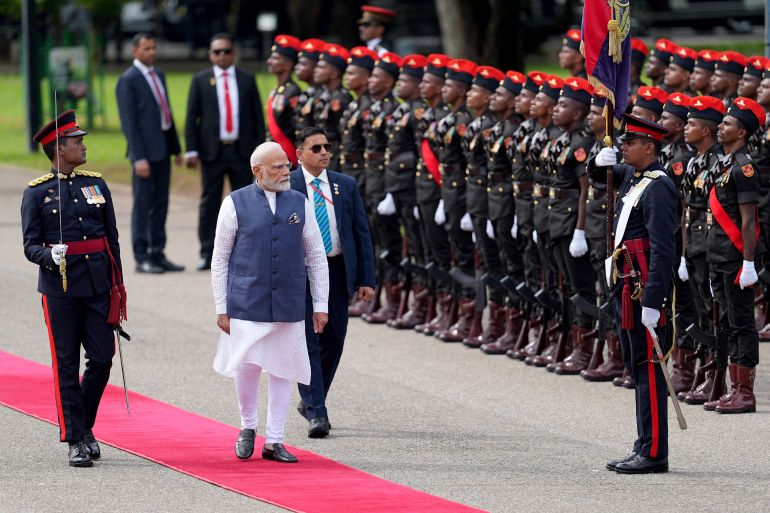India’s Modi visits Sri Lanka to shore up defence and energy ties
The Indian leader is the first foreign dignitary to visit the island nation since the leftist Dissanayake swept elections last year.

Published On 5 Apr 20255 Apr 2025
Indian Prime Minister Narendra Modi is in Sri Lanka to strengthen historical defence and energy ties as Colombo balances ties with its powerful neighbour and biggest lender, China.
Sri Lankan President Anura Kumara Dissanayake rolled out the red carpet for Modi and welcomed him with a 19-gun salute in the capital’s Independence Square on Saturday.
Recommended Stories
list of 4 itemsend of list
The Indian leader is the first foreign dignitary to visit the island since the leftist Dissanayake swept elections last year.
Modi was also conferred with Mithra Vibhushan, Sri Lanka’s highest civilian honour, by Dissanayake.
The Indian leader thanked the Sri Lankan president and said the honour was “not just mine but it belongs to the 140 crore [1.4 billion] people of India.”

“We believe that our security interests are aligned,” Modi said during a televised ceremony from Dissanayake’s office in Colombo. “Our security is interdependent and interconnected.”
Advertisement
The two nations signed a five-year defence cooperation agreement for the training of Sri Lankan military personnel in India as well as information and technology sharing.
Dissanayake applauded what he called “India’s rise as a world power, not just a regional power”.
“I have reiterated our position to Prime Minister Modi that Sri Lankan territory will not be allowed to be used by anyone to undermine India’s security,” he added.
India has previously objected to Chinese submarines and research vessels which have called at the main seaport in Colombo. Sri Lanka has not allowed Chinese submarines to dock since 2014, after India raised concerns over two such visits.
Last year, Colombo imposed a ban on foreign research vessels following New Delhi’s accusations that Chinese ships were being used to spy on India.
But the visit’s highlight was the launch of a 120-megawatt solar power plant in Sampur in the island’s northeastern Trincomalee district. The plant had been stalled for years but was reinvigorated with New Delhi’s backing as a joint project.
Reporting from Colombo, Al Jazeera’s Minelle Fernandez said Dissanayake was also expected to discuss the issue of fishermen from the southern Indian state of Tamil Nadu allegedly encroaching into Sri Lankan territorial waters.
“Hundreds of Indian trawlers are carrying away fish using a mechanised system called bottom trawling, which is also destroying the environment,” she said.
Balancing act
Modi’s visit came as Colombo grapples with the competing interests of New Delhi and Beijing.
Advertisement
India has been concerned about China’s growing sway in Sri Lanka, which it considers to be within its sphere of geopolitical influence.
Dissanayake’s first foreign visit as president was to New Delhi in December, but he followed that with a visit to Beijing in January, underscoring Sri Lanka’s delicate balancing act.
China has emerged as Sri Lanka’s largest single bilateral creditor, accounting for more than half of its $14bn bilateral debt at the time the island defaulted on its sovereign debt in 2022.
Beijing was the first to restructure its loans to Sri Lanka, a move that cleared the way for the island to emerge from that year’s worst-ever economic meltdown.
Colombo also signed an agreement in January with a Chinese state-owned company that will invest $3.7bn in an oil refinery in the island’s south. It would be Sri Lanka’s largest single foreign investment and is seen as crucial for the island’s economy.
Modi arrived in Sri Lanka late on Friday from a summit in Thailand and a string of meetings with leaders of regional nations as he sought to shore up India’s relations with neighbours.
On the sidelines of the Bangkok BIMSTEC meeting – the grouping of the seven nations on the Bay of Bengal – Modi held a rare face-to-face meeting with Myanmar’s military government chief Min Aung Hlaing.
Modi also held talks with Muhammad Yunus, the interim leader of neighbouring Bangladesh – the first such meeting since a revolution in Dhaka removed New Delhi’s long-term ally Sheikh Hasina.
Advertisement
India was the biggest benefactor of Hasina’s government and her overthrow sent cross-border relations into a tailspin, culminating in Yunus choosing to make his first state visit last month to China.
Modi also met on Friday in Bangkok with his Nepali counterpart KP Sharma Oli, the first since Kathmandu’s leader returned to power last year, as well as Tshering Tobgay of Bhutan.
